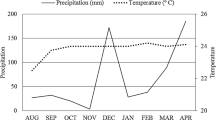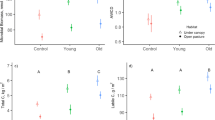Abstract
Soil invertebrates are the major determinants of soil processes such as organic matter decomposition and nutrient cycling. However, the effect of quantity and quality of organic inputs on soil biota has not been studied in agroforestry systems in southern Africa. Variations in soil macrofauna abundance under maize grown in fallows of Gliricidia sepium, Acacia anguistissima, Leucaena collinsii, Leucaena diversifolia, Leucaena esculenta, Leucaena pallida, Senna siamea, Calliandra calothyrsus and monoculture maize were assessed at three sites with contrasting agro-ecological conditions in eastern Zambia. It was hypothesised that spatial variations in soil macrofauna abundance under maize crops are mediated by heterogeneity in the quality and quantity of organic inputs produced by these legumes. The relationships between the abundance of macrofauna groups and litter, leaf, stump re-sprout and recycled biomass, stump survival and the quality index lignin (L)+polyphenol (P) to nitrogen (N) ratio were assessed using generalised linear models assuming spatial randomness (Poisson distribution) and aggregation (negative binomial distribution). Earthworms, beetles and millipedes showed spatial aggregation, which was partly explained by the heterogeneity in organic resource quantity and quality. Earthworms and beetles were more abundant under legumes that produced high quantities of biomass with low (L + P) to N ratios and species that have high stump survival after coppicing. Millipedes were favoured by species which produced high quantities of biomass with high (L + P) to N ratios. Although ants and termites showed spatial aggregation, their distributions were not influenced by the quantity or quality of biomass produced by the legumes. Centipedes and Arachnida showed spatial randomness, and their distribution was not influenced by any of the organic quality and quantity variables.

Similar content being viewed by others

References
Anderson JM, Ingram JSI (1993) Tropical soil biology and fertility. A handbook of methods, 2nd edn. CAB International, Wallingford, UK, pp 221
Barrios E, Kwesiga F, Buresh RJ, Sprent JI (1997) Light fraction soil organic matter and available nitrogen following trees and maize. Soil Sci Soc Am J 61:826–831
Chirwa TS, Mafongoya PL, Mbewe DNM, Chishala BH (2004) Changes in soil properties and their effects on maize productivity following Sesbania sesban and Cajanus cajan improved fallow systems in eastern Zambia. Biol Fertil Soils 40:28–35
Fletcher D, MacKenzie D, Villouta E (2005) Modelling skewed data with many zeros: a simple approach combining ordinary and logistic regression. Environ Ecol Stat 12:45–54
Hurvich CM, Tsai CL (1989) Regression and time series model selection in small samples. Biometrika 76:297–307
Johnson JB, Omland KS (2004) Model selection in ecology and evolution. Trends Ecol Evol 19:101–108
Lavelle P, Senapati B, Barros E (2003) Soil Macrofauna. In: Schroth G, Sinclair FL (eds). Trees, crops and soil fertility: concepts and research methods. CAB International, Wallingford, UK pp 303–323
Lawless JF (1987) Negative binomial and mixed Poisson regression. Can J Stat 15:209–225
Mafongoya PL, Giller KE, Palm C (1998a) Decomposition and nitrogen release patterns from tree prunings and litter. Agrofor Syst 38:77–97
Mafongoya PL, Nair PKR, Dzowela BH (1998b) Nitrogen mineralization from multipurpose tree prunings as affected by their chemical composition. Biol Fertil Soils 27:143–148
Mafongoya PL, Kuntashula E, Sileshi G (2006) Managing soil fertility and nutrient cycles through fertilizer trees in southern Africa. In: Uphoff N, Ball AS, Fernandes E, Herren H, Husson O, Liang M, Palm C, Pretty J, Sanchez P, Sanginga N, Thies J (eds) Biological approaches to sustainable soil systems. Taylor & Francis, NY, pp 274–289
Royle JA (2004) N-mixture models for estimating population size from spatially replicated counts. Biometrics 60:108–115
Sanchez PA (2002) Soil fertility and hunger in Africa. Science 295:2019–2020
SAS (2003) SAS/STAT, Release 9.1. SAS Institute Inc, Cary, NC, USA
Sileshi G, Mafongoya PL (2006) Variation in macrofaunal communities under contrasting land use systems in eastern Zambia. Appl Soil Ecol 33:49–60
Sileshi G, Mafongoya PL, Kwesiga F, Nkunika P (2005) Termite damage to maize grown in agroforestry systems, traditional fallows and monoculture on nitrogen-limited soils in eastern Zambia. Agric For Entomol 7:61–69
Taylor LR (1961) Aggregation, variance and the mean. Nature 189:732–735
Warton DI (2005) Many zeros does not mean zero inflation: comparing the goodness-of-fit of parametric models to multivariate abundance data. Environmetrics 16:275–289
Acknowledgements
We thank P. Phiri, S. Chikale, M. Chitalu and F. Phiri (Zambia/ICRAF) for data collection and soil analyses. Financial support for this study came from the Canadian International Development Agency (CIDA) and Swedish International Development Agency (SIDA).
Author information
Authors and Affiliations
Corresponding author
Rights and permissions
About this article
Cite this article
Sileshi, G., Mafongoya, P.L. Quantity and quality of organic inputs from coppicing leguminous trees influence abundance of soil macrofauna in maize crops in eastern Zambia. Biol Fertil Soils 43, 333–340 (2007). https://doi.org/10.1007/s00374-006-0111-8
Received:
Accepted:
Published:
Issue Date:
DOI: https://doi.org/10.1007/s00374-006-0111-8



